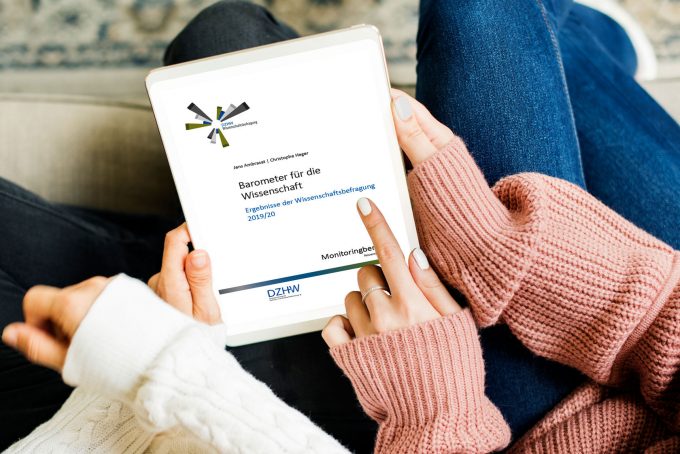
Horizon Report 2021: Focus on Hybrid Learning, Microcredentialing and Quality Online Learning
Rarely has an event impacted higher education as much as the corona pandemic. That's why it's no surprise that three new thematic blocks have found their way into the groundbreaking Horizon Report 2021: hybrid and blended learning, microcredentialing and quality online learning. We summarise the role they and old acquaintances such as OER, AI and learning analytics will play in higher education in the future.
by Claudia Sittner

The 2021 EDUCAUSE Horizon Report Teaching and Learning Edition was published at the end of April 2021 and looks at what trends, technologies and practices are currently driving teaching and learning and how they will significantly shape its future.
The report runs through four different scenarios of what the future of higher education might look like: growth, constraint, collapse or transformation. Only time will tell which scenario prevails. With this in mind, we looked at the Horizon Report 2021 to see what trends it suggests for academic libraries and information infrastructure institutions.
Artificial Intelligence
Artificial intelligence (AI) has progressed so rapidly since the last Horizon Report 2020 that people cannot catch up fast enough to test the technical advances of machines in natural language proceedings. Deep learning has evolved into self-supervised learning, where AI learns from raw or unlabelled data.
Artificial intelligence has a potential role to play in all areas of higher education where learning, teaching and success are concerned: support for accessible apps, student information and learning management systems, examination systems and library services, to name but a few. AI can also help analyse learning experiences and identify when students seem to be floundering academically. The much greater analytics opportunities that have emerged as the vast majority of learning events take place online, leaving a wide trail of analysable data, can help to better understand students and adapt learning experiences to their needs more quickly.
But AI also remains controversial: for all its benefits, questions about privacy, data protection and ethical aspects often remain unsatisfactorily answered. For example, there are AI-supported programmes that paraphrase texts so that other AI-supported programmes do not detect plagiarism.
Open Educational Resources
For Open Educational Resources (OER), the pandemic has not changed much, many of the OER offerings are “born digital” anyway. However, advantages of OER such as cost savings (students have to buy less literature), social equality (free and from everywhere) and the fact that materials are updated faster are gaining importance. Despite these obvious advantages and the constraints that corona brought with it, however, only a few teachers have switched to OER so far as the report „Digital Texts in Times of COVID” (PDF) shows. 87% of teachers still recommend the same paid textbooks.
OER continue to offer many possibilities, such as teachers embedding self-assessment questions directly into pages alongside text, audio and video content, and students receiving instant feedback. In some projects, libraries and students are also involved in the development of materials as OER specialists, alongside other groups from the academic ecosystem, helping to break down barriers within the discipline and redesign materials from their particular perspective.
In Europe, for example, the ENCORE+ – European Network for Catalyzing Open Resources in Education is working to build an extensive OER ecosystem. Also interesting: the „Code of Best Practices in Fair Use für Open Educational Resources”. It can be a tool for librarians when they want to create OER and use other data, including copyrighted data.
Learning Analytics
Online courses generate lots of data: How many learners have participated? When did they arrive? When did they leave? How did they interact? What works and what doesn’t? In higher education, learning data analysis should help make better, evidence-based decisions to best support the increasingly diverse group of learners. Academic libraries also often use such data to better understand and interpret learner needs, respond promptly and readjust.
The Syracuse University Libraries (USA), for example, have transmitted its user data via an interface to the university’s own learning analysis programme (CLLASS). A library profile was developed for this purpose, which was consistent with the library’s values, ethics, standards, policies and practices. This enabled responsible and controlled transmission of relevant data, and a learner profile could be created from different campus sources.
Just as with the use of artificial intelligence, there are many objections in this area regarding moral aspects and data protection. In any case, the handling of such learning data requires sensitisation and special training so that teachers, advisors and students can use data sensibly and draw the right conclusions. In the end, students could also receive tailored virtual support throughout the entire process from enrolment to graduation. Infrastructures for data collection, analysis and implementation are essential for this.
Microcredentials
Microcredentials are new forms of certification or proof of specific skills. They are also better suited to the increasingly diverse population of learners than traditional degrees and certificates. Unlike these, they are more flexible, designed for a shorter period of time and often more thematically focused. The spectrum of microcredentials spans six areas from short courses and badges, to bootcamps and the classic degree or accredited programmes.
Microcredentials are becoming increasingly popular and can also be combined with classic certifications. The Horizon Report 2021 sees particular potential for workers who can use them to retrain and further their education. It is therefore hardly surprising that companies like Google are also appearing on the scene with Google Career Certificates. For many scientific institutes, this means that they will have to further develop and rethink the architecture, infrastructure and work processes of their traditional certification systems.
Blended and Hybrid Course Models
Due to the corona pandemic, diverse blended and hybrid course models mushroomed, especially in the summer of 2020. “It is clear that higher education has diversified quickly and that these models are here to stay”, the report says. Hybrid courses allow more flexibility in course design; institutions can ramp up capacity as needed and cater even more to the diverse needs of students. However, most students still prefer face-to-face teaching.
Newly learned technical skills and technical support have played a predominant role. In some places, new course models have been developed together with the learners. On the other hand, classic practices (such as frequent assessments, breakout groups during live course meetings, and check-in messages to individual students) remain high on the agenda. However, corona has brought mental and social health of all participants into sharper focus; it should also receive even more attention according to the Horizon Report.
Quality Online Learning
The coronavirus came along and everything suddenly had to take place online. So it is little wonder that the need to design, meaningfully evaluate and adapt high-quality online learning opportunities has increased enormously. Some were surprised to find that teaching online involved more effort than simply offering the on-site event via Zoom. In order to achieve learning success, online quality assurance became an issue of utmost relevance.
Early in the pandemic, therefore, institutes began to develop online portals or hubs that included materials and teaching strategies adapted to the situation: for content delivery, to encourage student participation and to rethink assessment mechanisms.
A positive example is the twelve-module course “Quickstarter Online-Lehre” (Quickstarter Online Teaching, German) by the Hochschulforum Digitalisierung – German Forum for Higher Education in a digital age and the Gesellschaft für Medien in der Wissenschaft (Society for media in science) from Germany. This course aims to support teachers with no or little online experience.
This text has been translated from German.
This might also interest you:
- Horizon Report 2020: AI, XR and OER Begin to Catch on in Higher Education
- Horizon Report 2019: How new Technologies lead to a Redesign of Learning and Teaching
- Digital Badges: Clever Proof of Information Literacy
- Study “The University Landscape 2030”: Opening up through new study models
Claudia Sittner studied journalism and languages in Hamburg and London. She was a long time lecturer at the ZBW publication Wirtschaftsdienst – a journal for economic policy, and is now the managing editor of the blog ZBW MediaTalk. She is also a freelance travel blogger (German), speaker and author. She can also be found on LinkedIn, Twitter and Xing.
Portrait: Claudia Sittner©
View Comments

Research Data Management Project bw2FDM: Best Practice for Consultations and Training Seminars
Best practice examples often provide guidance and suggestions for tackling tricky...



